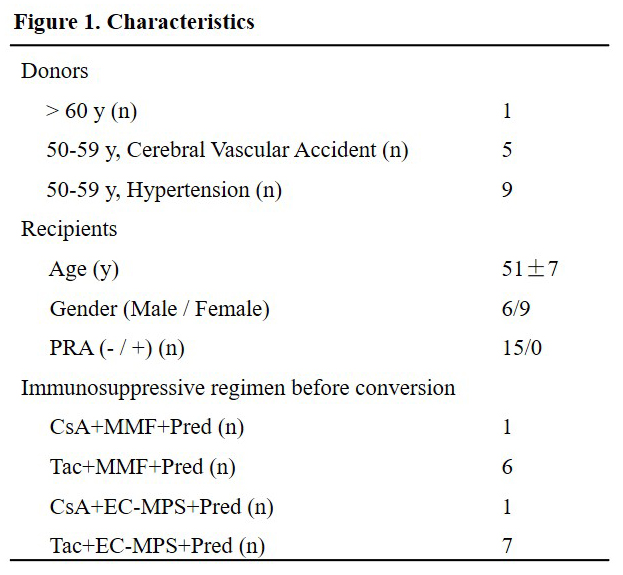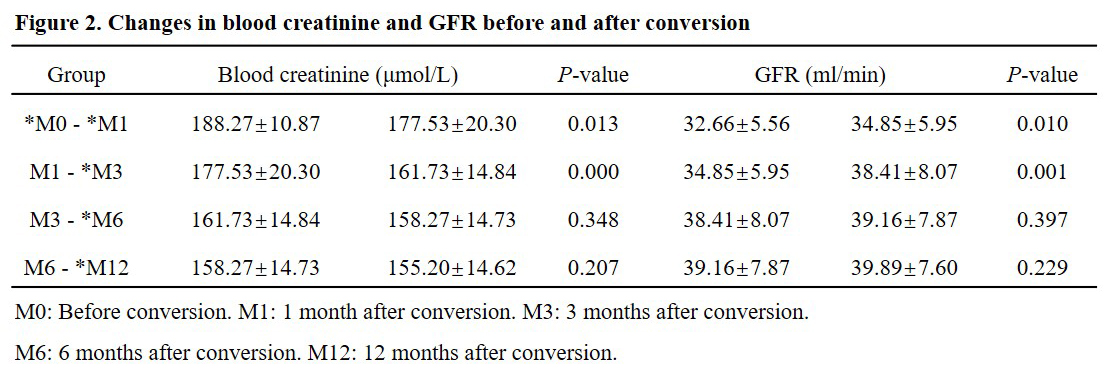Sirolimus Combined with Low-Dose Calcineurin Inhibitor in Kidney Transplant Recipients from Expanded Criteria Donors
Beijing Friendship Hospital, Capital Medical University, Beijing, China
Meeting: 2020 American Transplant Congress
Abstract number: C-115
Keywords: Calcineurin, Immunosuppression, Kidney transplantation, Sirolimus (SLR)
Session Information
Session Name: Poster Session C: Kidney Immunosuppression: Novel Regimens and Drug Minimization
Session Type: Poster Session
Date: Saturday, May 30, 2020
Session Time: 3:15pm-4:00pm
 Presentation Time: 3:30pm-4:00pm
Presentation Time: 3:30pm-4:00pm
Location: Virtual
*Purpose: To evaluate the efficacy and safety of conversion from calcineurin inhibitor-based immunosuppressive regimen to sirolimus combined with low-dose calcineurin inhibitor in recipients with abnormal allograft function after kidney transplantation from expanded criteria donors (ECDs).
*Methods: Prospective, open-label, non-randomized controlled clinical study was conducted. Totally 15 patients with abnormal renal function after the first transplant from ECDs were enrolled, who converted calcineurin inhibitor regimen to sirolimus combined with low-dose calcineurin inhibitor 3 months after transplantation during June 2017 and March 2018 (Figure 1). All patients were followed up over 1 year. The allograft survival time, changes in blood creatinine and glomerular filtration rate (GFR), changes in urinary protein, the incidence of acute rejection, BK virus, cytomegalovirus infection and sirolimus-related complications were observed.
*Results: The renal function of all 15 patients was improved after conversion and 1-year allograft survival rate was 100% (15/15). Serum creatinine significantly decreased and GFR significantly increased at 1 month and 3 months after conversion (P<0.05) (Figure 2). BK viruria was detected in 5 patients before conversion. After conversion, BK virus turned into negative in 3 patients within 3 months and the viral load in other 2 patients also decreased. Only 2 patients (13.3%) developed de novo mild proteinuria. 8 patients (53.3%) developed de novo hypertriglyceridemia, which could be controlled acceptably by medicine. Other common complications, such as myelosuppression, pulmonary infection and oral ulcer, were not observed in this study. None of the patients experienced acute rejection during follow-up.
*Conclusions: Sirolimus combined with low-dose calcineurin inhibitor is a safe and effective maintenance immunosuppressive regimen for patients receiving ECDs, especially for those with abnormal renal function during recovery. This regimen may improve the renal function and control BK virus infection. However, it cannot completely replace calcineurin inhibitor-based immunosuppressive regimen. Individualized treatment is needed.
To cite this abstract in AMA style:
Zhang J, Lin J, Tian Y, Sun W, Zhang L. Sirolimus Combined with Low-Dose Calcineurin Inhibitor in Kidney Transplant Recipients from Expanded Criteria Donors [abstract]. Am J Transplant. 2020; 20 (suppl 3). https://atcmeetingabstracts.com/abstract/sirolimus-combined-with-low-dose-calcineurin-inhibitor-in-kidney-transplant-recipients-from-expanded-criteria-donors/. Accessed December 19, 2025.« Back to 2020 American Transplant Congress


